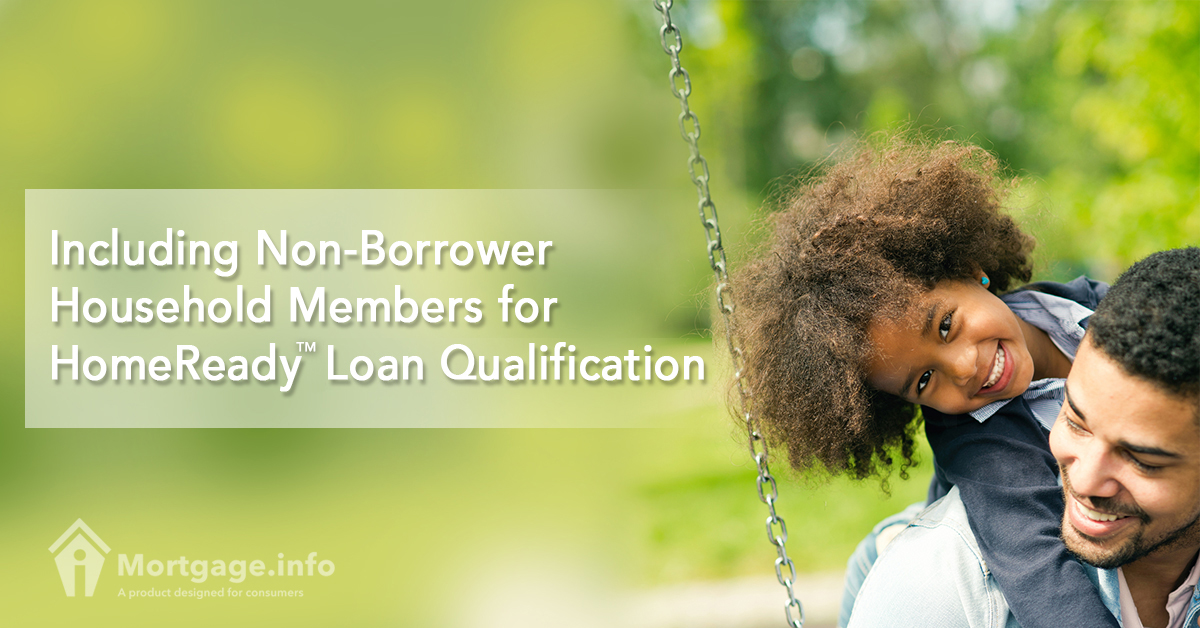
HomeReady™ loans are among the only loans that allow you to use non-borrower income in order to get approved for a loan. This income does not get included as your qualifying income, but rather as a compensating factor. Think of it as reserves that would help you get approved for a conventional loan that you were on the border of being able to get approved to receive. If your debt ratio was just over the line or your credit score was just a point or two away from the minimum score allowed, having 6 to 12 months’ worth of reserves on hand could help you get that approval. The same is true for the HomeReady™ loan and non-borrower income. It helps give the lender reassurance that you will be able to get the mortgage paid despite your low income/high debt ratio in combination with your good credit.
Who is a Non-Borrower?
Non-borrowers are people that live with you in your home that are not the actual borrowers. For example, if you and your spouse want to purchase a home, but your debt ratio is 46%, you would not qualify for a loan under the Qualified Mortgage guidelines because the maximum debt ratio allowed is 43%. This would leave you without conventional financing as an option and with only sub-prime loans as a backup plan. If you have other people living with you, whether they are your adult children, other extended family members, or friends, though, you may be able to use their income to help you qualify for the loan. The lender looks at their income as a compensating factor, because studies show that families that live in low-income and high-minority areas tend to have multiple family members or friends living with them to help make ends meet. The HomeReady™ guidelines state that you do not have to be a blood relative in order to be considered a non-borrower.
How to Document Household Membership
The biggest trick is documenting household membership in order to have non-borrower income included in the factors that determine your eligibility for a HomeReady™ loan. You have to officially document the household membership in order for the income to be considered. This is done with Fannie Mae Form 1019. This form requires the non-borrower to state his name, source of income, and monthly amount of income. The document also requires the non-borrower(s) to sign a statement at the bottom of the form stating that they intend to live with the borrower for at least the next 12 months.
Documenting the Income
The Fannie Mae Form 1019 also states that the non-borrower will provide ample evidence to document his income. Although the income is not used for qualifying purposes and no credit information from the non-borrower is required, proper verification of the income is necessary. This is because the lender looks at the non-borrower income as a way to help out with household expenses. For example, if you claim that your father is going to live with you when you purchase a home with the HomeReady™ loan and your debt ratio is 46% and your father has a steady monthly income of $1,000, the lender needs to verify that income. This allows the lender the reassurance that your father will contribute to the household expenses should you be unable to afford them. In order to verify income of a non-borrower, the same steps need to be taken that you took, including:
- Provide the last 2 paystubs or the paystubs that cover the last month worth of income
- Provide the last 2 years’ of W-2s to document the average income over that time
- Provide tax returns for the last two years if the non-borrower is self-employed
The proper proof of income will allow the lender to verify it and use it as a compensating factor. In addition, it allows the lender to determine that the non-borrower income being used totals at least 30% of the total income for the borrowers on the loan.
When Non-Borrower Income Cannot be Used
There are certain circumstances when non-borrower income cannot be used. While the HomeReady™ loan has flexible guidelines, they do restrict when this income is used so that the program is not abused. The following examples show these situations:
- If your debt ratio with yourself and any other borrowers on the loan is less than 45%, you must qualify on your own for the loan – no non-borrower income can be used.
- If your debt ratio with yourself and any borrowers on the loan is higher than 50%, you will not qualify for the loan even with compensating factors.
- If the non-borrower income does not total at least 30% of your qualifying income. This means the total from all non-borrowers, so if you have more than one, the income can be combined to reach the 30% threshold.
The HomeReady™ loan is rather flexible in its allowance for using non-borrower income, but you have to follow the strict guidelines in order to use this income. This means verifying the income and ensuring that it meets the minimum requirements that Fannie Mae set. This program is a great way to get into a home in a low-income or high-minority area, especially if you have good credit, but cannot qualify for any other conventional loan program because of your debt to income ratio. Having other members live with you and help you with the bills is a great way to obtain the loan and become a homeowner rather than being stuck as a renter your entire life.
Most lenders that offer Fannie Mae loans offer the HomeReady™ program, but every lender will allow different circumstances. Take the time to shop with several lenders to ensure that you are getting the best interest rates and fees on the program. Some lenders will be more relaxed with their requirements than others, so shop around to find the program that fits your financial needs the most.
